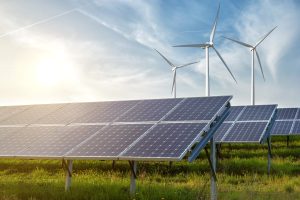As the energy landscape continues to evolve, Wabash Valley Power Alliance (WVPA) remains committed to investing in a diverse portfolio of generation sources. From intermittent renewables to traditional fossil fuels, transitioning to renewable energy sources is key to providing reliable, affordable, and increasingly sustainable energy. There are various renewable generation resources, each with its own specific benefits, and potential downsides. But each source plays a critical role in WVPA’s goal of reaching net-zero carbon emissions by 2050.
 Intermittent renewable sources, including wind and solar power, are being utilized more often, but they also bring a unique set of challenges. Solar and wind power typically require minimal operating costs after installation and have zero greenhouse gas emissions during operation, but their output fluctuates based on weather, time of year, and time of day. Downward fluctuations mean intermittent renewables cannot be dispatched, which disrupts conventional grid operation. Fully utilizing these energy sources requires addressing fluctuations and identifying more effective storage solutions.
Intermittent renewable sources, including wind and solar power, are being utilized more often, but they also bring a unique set of challenges. Solar and wind power typically require minimal operating costs after installation and have zero greenhouse gas emissions during operation, but their output fluctuates based on weather, time of year, and time of day. Downward fluctuations mean intermittent renewables cannot be dispatched, which disrupts conventional grid operation. Fully utilizing these energy sources requires addressing fluctuations and identifying more effective storage solutions.
Dispatchable renewables, such as hydroelectric and geothermal, are more flexible than intermittent renewables and offer a different set of advantages. These sources can be turned on or off, depending on demand, providing a level of flexibility that’s invaluable for energy management. While their operating costs are higher than those of intermittent renewables, they are still lower than fossil fuels and have a minimal environmental impact.
To meet peak demand, combustion turbines and combined cycle turbines must be included as part of the overall key strategy. Although they are less efficient and more expensive to operate than other sources, combustion turbines offer low emissions, high heat recovery and are low maintenance. Combined cycle turbines are another option — providing a more efficient alternative to simple cycle turbines. By running on multiple types of fuel, these turbines provide a level of flexibility that makes them an attractive transitional technology while more sustainable options are explored.
Landfills could play a key role in the transition to renewable energy sources and reducing carbon emissions. Landfill generators turn waste into energy, utilizing landfill gas as a fuel source, reducing the need for additional transportation. These generators also help to reduce methane emissions, resulting in a positive impact on communities and the environment. Their emissions are also lower compared to coal, making them another sustainable option for energy generation.
With its high energy density, coal has long been a cornerstone of the energy mix. However, coal comes with unique challenges, including the need for train transportation and significant emissions of CO2 and other pollutants. Recognizing these drawbacks, WVPA is committed to reducing its reliance on coal in favor of cleaner energy alternatives.
While renewable energy sources are becoming increasingly competitive in energy markets, there are still challenges to overcome. Natural gas pipeline constraints and coal transportation issues can add to costs and emissions. Additionally, transmission congestion can affect the ability to move energy from one origin point to where it’s needed — all challenges WVPA is actively addressing to ensure a reliable and sustainable energy supply.
By understanding the unique characteristics and challenges of different generation sources, we are better equipped to make informed decisions that benefit both members and our communities.

